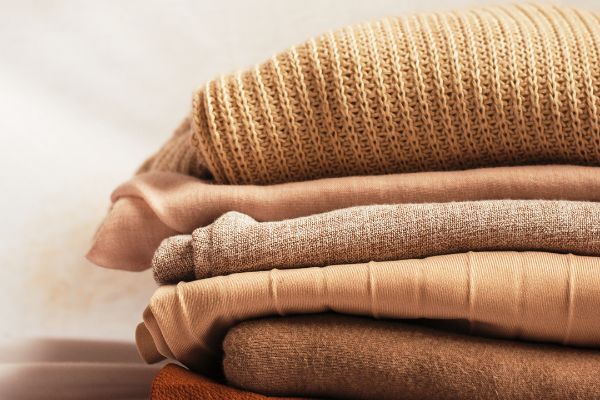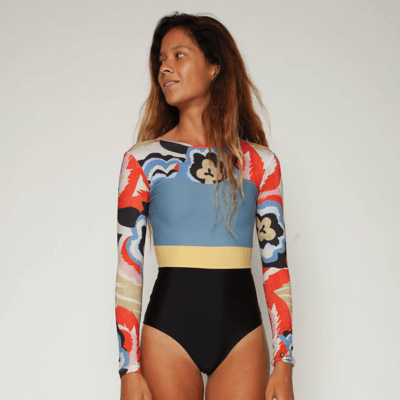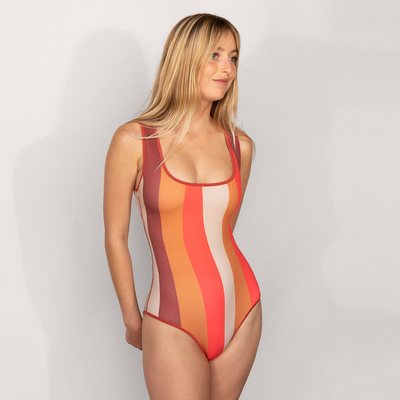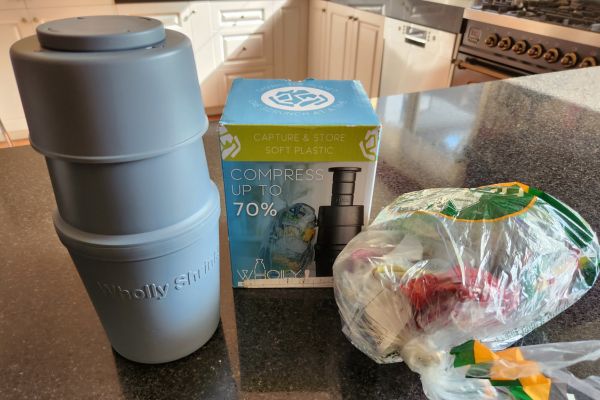25 billion gallons of fresh water are used to produce one year’s worth of new clothing1. Yet 2 billion people worldwide lack access to clean water — and this amount will only go up unless we cut down our water consumption.2
But you can help to alleviate this global water crisis by doing something as simple as switching to sustainable fashion in place of mainstream fast fashion. Recycled fabrics and other sustainable fabrics require significantly fewer resources for production. And they don’t pollute our precious water sources when they are being processed.
If you are interested in sustainable clothing but aren’t sure how to choose the right fabrics and which brands to buy from — then this simple guide is for you.
What Are The Best Eco-Friendly Fabrics?
There Are Two Main Types Of Sustainable Fabrics:
- Natural, biodegradable materials
- Recycled, synthetic materials
Natural materials such as organic cotton, hemp, bamboo fiber, and linen are sustainable for the environment. Unlike synthetic fibers, natural materials are biodegradable and don’t pollute the soil or water as they break down.
It’s best to choose organic, fair-trade, toxic dye-free fabrics when buying clothes made from natural materials wherever possible. Because non-organic natural fabrics such as GMO cotton use a lot of water, pesticides, and still cause pollution even if they are biodegradable — so they are not strictly sustainable or gentle on the environment. They still hold a lot of other beneficial properties – but if you’re looking for eco-friendly fabrics it’s always best to choose organic as they have a lower negative impact on the earth in the long term.
Then you have recycled synthetic materials. Many clothes are either made from synthetic fibers or have synthetic fibers woven into the fabric to improve the strength, sheen, or elasticity of the cloth. Recycled synthetic materials are better for the environment than virgin (newly produced) synthetic fabrics. They are made from waste materials rescued from landfill, and keeping these materials in circulation supports the circular economy.
An Easy List Of The Best Sustainable And Recycled Fabrics
So you’re starting your journey of responsible shopping and you want a low-down on the sustainable fabrics available. Here is a list of common eco-friendly fabrics that you’ll find on the conscious consumer market.
There are so many great brands that offer eco-friendly fabrics at great prices, that you’ll be spoilt for choice. At Everyday Recycler, we bring you the best sustainable brands, and the coolest designs so that you can have the best of both worlds — kind fashion.
1) Organic Cotton
Specifically, look for brands that use organic cotton in their clothing wherever you can. 2700 liters of water is used to produce one non-organic GMO t-shirt3. And non-organic cotton is grown using harmful fertilizers and insecticides — which eventually leach into and poison our waterways and soil.
If you’re looking for an ethical fashion brand that uses organic cotton and plants 10 trees for every ethical clothing purchase you make, then be sure to check out TenTree.
We especially love TenTree’s Juniper Hoodie — which is made of 60% organic cotton and 40% recycled polyester. Save the planet in style and comfort by ordering your Juniper Hoodie now.
2) Econyl
Nylon waste from discarded fishing nets and landfill waste remains in the ground and oceans for thousands of years. As they break down, they release microplastics which pollute our drinking water and our food. Microplastics are a massive issue, and are contaminating our food chain.
Econyl is a sustainable fabric made from discarded fishing nets, plastic bottles, and other nylon waste which is collected, cleaned, and reprocessed to make fabrics. This process uses less water and energy than brand-new nylon. And it prevents nylon from ending up in landfills or in the ocean.
Baiia is a sustainable clothing brand that creates stunning clothes and beachwear using Econyl and 100% organic cotton. Shop from their beautiful range of men & women’s clothing to help reduce textile waste.
Another fantastic clothing brand to check out is DK Active. DK Active creates activewear made from econyl, organic cotton, and bamboo. Their clothes are comfortable, trendy, breathable, and sustainable. DK Active creates the perfect combination of high-impact workouts and low environmental impact fashion.
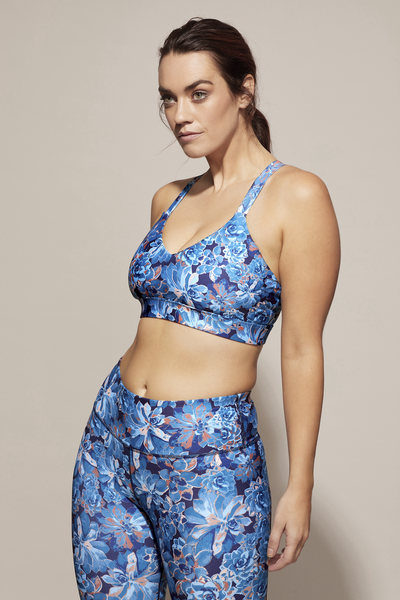

3) Tencel
Tencel fabrics are made from sustainably sourced wood pulp. They are carbon neutral, biodegradable, and made using renewable energy sources. And Tencel also combines recycled fibers into their Tencel X Refibra fabric which gives a new lease of life to cotton scraps.
Tentree makes clothes with Tencel too. This Cypress Tank is a great piece.
4) EcoLux/EcoRib/EcoTex
Vitamin A is an ethical brand that always deserves a special mention because of its efforts towards sustainability and environmental protection.
Fun fact; Vitamin A has developed a unique range of high-quality, sustainable materials that are made from recycled fibers:
- EcoLux (recycled nylon + lycra): super stretchy and moisture-wicking
- EcoRib (recycled nylon fabric scraps): lightweight, soft, and saves 33 liters of water per meter of fabric
- EcoTex (recycled nylon + lycra): superfine and form-fitting
For every purchase you make from Vitamin A’s website, a portion of your sale goes towards cleaning up trash from the ocean. Check out their range of clothing and sustainable swimwear here.
5) Recycled Polyester And Repreve
A whopping 10 million tonnes of plastic ends up in our oceans each year. And 14% of this comes from plastic bottles.4
Recycled polyester fabric (RPET) is a small contribution to reducing how much plastic ends up in our oceans. Made from discarded plastic bottles that are cleaned, shredded, and processed to make fabric, RPET is durable, soft, and helps to keep our ocean trash free.
TenTree’s Longline Active Bra is made from RPET (recycled polyester). This eco-friendly active bra is made from a closed-loop process that recycles post-consumer plastic. It’s stylish, comfy, and made from 79% recycled polyester. Just from buying this bra, you save 0.95 liters of water and 0.19kg of CO2 (carbon dioxide).
Made from 100% recycled plastic bottles, Repreve is a soft, durable fabric that reduces the usage of new petroleum and keeps trash away from landfills.
Seea is one of our go-to sustainable fashion brands for swimwear. Seea makes women’s clothing and sustainable swimwear using 100% recycled materials such as repreve and econyl. Their on-trend eco-friendly swimwear is a great investment into slow fashion. Give yourself the perfect excuse to get your dose of sun, and, and sea by treating yourself to a cute beach outfit from Seea.
What Are The Worst Fabrics For The Environment?
Ever wondered which fabrics are not so good for the environment? Here’s a list of fabrics that aren’t so easy on the environment.
1) GMO Cotton
Cotton is a popular natural material that has many benefits. Cotton is breathable and fully biodegradable which makes it a popular choice for eco-conscious consumers.
But non-organic GMO cotton accounts for 16% of the world’s insecticide use — which destroys local biodiversity. And not only that it uses 20,000 liters of groundwater to produce just one kg of cotton.5
Instead, look for clothes that use recycled cotton, organic cotton, or upcycled cotton wherever possible as they have all the benefits of a natural material whilst also being gentle on the earth. Organic cotton is generally grown using rainwater instead of groundwater resources, and there are no harmful chemicals, insecticides, or inorganic fertilizers used during its production. This helps to maintain soil health for future crops and keeps our waterways clean.
2) Virgin Polyester
52% of all fabric produced uses interwoven polyester because it provides stability, stretchability, and strength to fabric.6 But the issue is, not only is polyester made of plastic — virgin (or newly manufactured) polyester uses petrochemicals in its production.
Polyester material also sheds microfibers during production and every time you wash it. The microfibers released from the fabric remain in our waterways and soil for thousands of years.
If you like swimming in plasticless oceans, then you can help to protect the planet by choosing recycled polyester (RPET) where possible. Recycled polyester is made from discarded plastic bottles and helps to recycle plastic bottles and prevent old polyester from going to landfills.
3) Virgin Nylon
5.4 million tonnes of nylon is used each year to produce clothing.7 Nylon is yet another fabric that doesn’t decompose. Instead, nylon breaks down into tiny pieces — microplastics — which contaminate our food chain and waterways.
The good news is nylon can be recycled to create new products and materials. Try to choose recycled nylon, regenerated nylon, or Econyl wherever possible. They use less water and energy for creation, are overall better for the planet, and they prevent nylon deadstock fabric from going to landfills.
How Can I Make My Wardrobe More Sustainable?
One of the best parts of eco-friendly fashion in 2021 is that it has come such a long way. Gone are the days of looking through drab, shapeless, and boring eco-friendly dresses. We are now treated with vibrant, on-trend, gorgeous designs that are in tandem with the rest of the fashion world’s designs. So it’s safe to say – that you can look great and also prevent unnecessary harm to the planet.
The brands we mentioned in this guide are a great place to start if you want to wear sustainable clothing. They do all the thinking for you so you can shop guilt-free from their collections. And if you choose to buy from other brands that aren’t specifically sustainable, then try to choose fabrics that are natural, organic, and biodegradable or recycled wherever you can.
Tips For A Sustainable Wardrobe
Here are a few simple tips and tricks that help you to start transforming your wardrobe into an ethical fashion haven.
Use Clothes For Longer
Fast fashion has a bad reputation because people use and throw perfectly good clothes after just a few wears. Most of these clothes end up in landfills, and unfortunately many of the fabrics do not biodegrade.
Buy Quality Clothes
Instead of buying into temporary fast fashion fads. Choose sustainable clothing options which are timeless, as this allows you to use those clothes for a few years instead of a few weeks. And then you can upcycle them once they are unusable. Or you can simply swop with friends.
Thrift Your Clothes
Buy second-hand clothes from thrift shops, yard sales, and do clothes swaps. When you are bored of that old dress, don’t throw it out because someone else will love it as if it’s brand new!
And similarly, you can find clothes which are as good as new in thrift shops and yard sales.
By recycling and re-loving garments that are still wearable, you can cut the production of new clothes by a significant chunk. Imagine how much water, energy, and resources we could save?
Buy Sustainable Fabrics
Shop for sustainable clothing that is made from recycled fabric, eco friendly material, or biodegradable fabric. Brands that use sustainable fabrics are also more likely to pay their workers better wages, and have better working conditions. So it’s a win-win for everybody. Ethical fashion brands are passionate about humans, animals, and the environment.
Conclusion
Ethical fashion and sustainable living can be fun and rewarding when done properly. And the best part is — it’s really not hard to begin your sustainable fashion journey. Just start with small steps in the right direction, and before you know it you will have made some massive changes.
Remember to choose your fabrics wisely, use clothes longer, donate and upcycle clothes where you can. You can make a considerable difference to the effects of the fashion industry on the planet by switching from fast fashion brands to slow fashion.
Sources
- 1: https://www.thefashionlaw.com/how-many-gallons-of-water-does-it-take-to-make-a-single-pair-of-jeans/
- 2: https://www.sciencenews.org/article/future-will-people-have-enough-water-live
- 3: https://www.huffpost.com/entry/cottons-water-footprint-world-wildlife-fund_n_2506076
- 4: https://plasticoceans.org/the-facts/
- 5: https://www.worldwildlife.org/industries/cotton
- 6: https://www.oerlikon.com/en/investors/reports-publications/
- 7: 2019, Analyst Briefing ITMA Barcelona
- 8. https://pubmed.ncbi.nlm.nih.gov/29359236/


